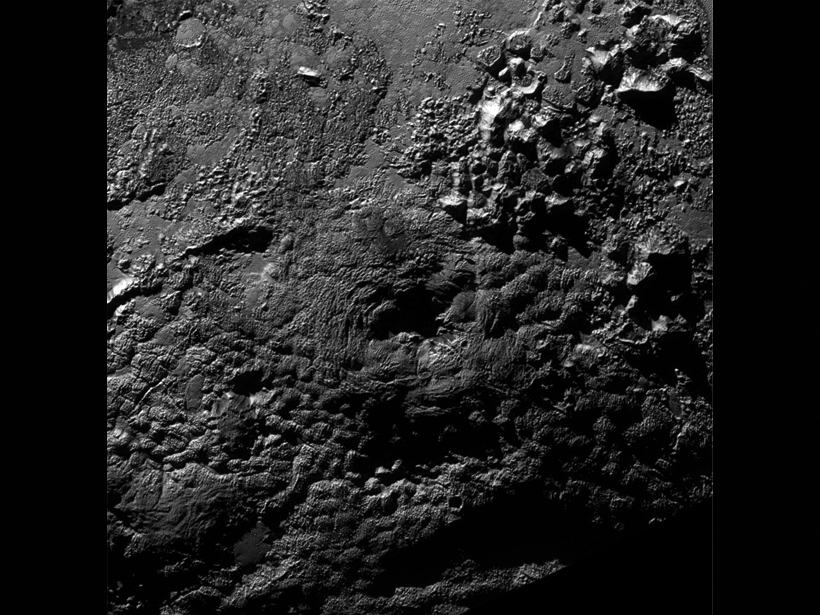Two newly discovered mountains on Pluto may be icy volcanoes that erupted in the relatively recent geologic past, astronomers announced Monday.
Along with these findings, researchers on Monday also unveiled cratering evidence across Pluto’s surface that suggests not only does the dwarf planet have some surprisingly youthful surface features, but it has remained geologically active throughout its existence.
“Pluto has been active … the whole time, it’s not just that all of a sudden it burped after 4 billion years of dormancy.”
“Pluto has been active … the whole time, it’s not just that all of a sudden it burped after 4 billion years of dormancy,” New Horizons lead scientist Alan Stern of the Southwest Research Institute in Boulder, Colo., told Eos.
New Horizons researchers reported both sets of findings 9 November at the annual meeting of the American Astronomical Society’s Division for Planetary Sciences in National Harbor, Md.
Volcanoes in Stereo
The potential volcanoes showed up on stereo images assembled by New Horizons researcher Oliver White of NASA’s Ames Research Center in Mountain View, Calif., and his colleagues from observations taken by the New Horizons spacecraft when it made a close flyby of Pluto on 14 July.
“Nothing like this has been seen anywhere in the outer solar system.”
Unlike chains of icy mountains previously seen by New Horizons, the volcanic features have large depressions at their tops that resemble calderas, said Stern. “Nothing like this has been seen anywhere in the outer solar system,” he said.
The larger of the two mounds, dubbed Wright Mons, lies just south and west of Sputnik Planum, a young, flat region. The other mound, known as Piccard Mons, lies farther south.
The stereo images, which could be compiled only after New Horizons radioed additional pictures earlier this fall, made it possible to discern the height and breadth of the volcano-like mounds, which stand a few kilometers tall and extend tens of kilometers. The stereo data also revealed that the depressions atop the mounds are too deep to be craters gouged by incoming space debris and are more likely to be volcanic in origin, said Stern.
The volcanoes are only lightly sprinkled with craters, suggesting that an eruption gave the region a facelift, erasing many of the older craters, said Stern. That activity might have occurred about a billion years ago, but age estimates are highly uncertain, he added.
Signs of Middle Age
In the separate report analyzing the density of craters blanketing Pluto, New Horizons scientist Kelsi Singer of the Southwest Research Institute and her colleagues found the first evidence for a middle-aged terrain on the dwarf planet.
Whereas even the sharpest New Horizons images of a region called Sputnik Planum do not show even a single crater, indicating that surface features there formed no more than 10 million years ago, a high density of craters peppers some areas elsewhere on Pluto, indicating that those surfaces formed nearly 4 billion years ago and have been dormant ever since.
However, in terrains recently identified by Singer and her colleagues in an area just east of Sputnik known as East Tombaugh, the density of craters lies somewhere in between. Calculations are not certain enough to pinpoint the exact vintage of these regions, according to Singer. Her favored model gives an average age of 1 billion years, she said, but other models indicate ages ranging from 200 million to 2 billion years. That’s important, Singer noted, because it indicates that Pluto has had enough internal heat to maintain surface activity throughout the lifetime of this outer solar system body.

Inner Ocean?
New Horizons geologist William McKinnon of Washington University in St. Louis told Eos that radioactive heating from Pluto’s core might have sufficed to keep the dwarf planet active all this time, especially if some of the heat had melted ice, temporarily creating an internal ocean—a scenario first investigated by researchers several decades ago. Later, when radiogenic activity had dwindled, the ocean could have refrozen, releasing heat that kept the surface activity going.
Now this hypothesis may take on added importance. “We’ve got a lot work ahead of us,” said McKinnon, to figure out all the new puzzles.
—Ron Cowen, Freelance Science Journalist; email: [email protected]
Citation: Cowen, R. (2015), Pluto: In the icebox but maybe still cookin’, Eos, 96, doi:10.1029/2015EO039213. Published on 9 November 2015.
Text © 2015. The authors. CC BY-NC 3.0
Except where otherwise noted, images are subject to copyright. Any reuse without express permission from the copyright owner is prohibited.

